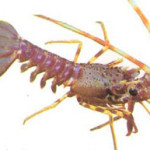
Haliotis sorenseni
The white abalone is the only mollusk currently listed under the Endangered Species Act by the National Marine Fisheries Service (NMFS). NMFS designated the white abalone as a candidate for listing in 1997 for the California region south to Baja California, Mexico. A short-lived commercial fishery began in the early 1970s, peaked middecade and collapsed in the 1980s. Only occasional landings occurred after that time. It was also sought after by recreational divers, but actual landings are unknown. Recent studies suggest that this species has likely suffered reproductive failure resulting from severe over-harvest. The fishery was closed in 1996.
The white abalone dwells in deep waters – 25 to over 65 metres (80 to 200ft) from Point Conception (southern California) southward to Baja California. Because of its depth range, this abalone was only described scientifically in 1940. It lives on rocky substratum such as pinnacles, rock piles, and deep reefs. Once occurring in numbers as high as 1 per square metre of suitable habitat, they now can be found only occasionally. Recent surveys found that densities average 1 per hectare (10,000 square metres) in the Channel Islands off southern California.
The white abalone is a herbivorous, marine, rocky benthic (bottom dwelling), broadcast spawning gastropod. The epipodium is tan and looks pebbly. The bottom of its foot is orange. The shell is oval-shaped, very thin and deep. They can be up to 10 inches, but are usually 5-8 inches. If fertilized, the eggs hatch after only one day, but high concentrations of sperm are required in order for an egg to be fertilized. Therefore, aggregations of adults are necessary for successful fertilization to occur. Currently, the white abalone are frequently found alone, and have little chance for successful fertilization. Because populations are only small fractions of former numbers, recovery will be complicated by loss of genetic diversity from genetic bottlenecks, genetic drift and founder effects.
Abalones are also vulnerable to various bacterial and parasitic infections. The fishery was historically managed using size limits and seasons, but such methods failed because they did not account for density dependent reproduction and assumed regular successful settlement of the larvae.








Social Profiles